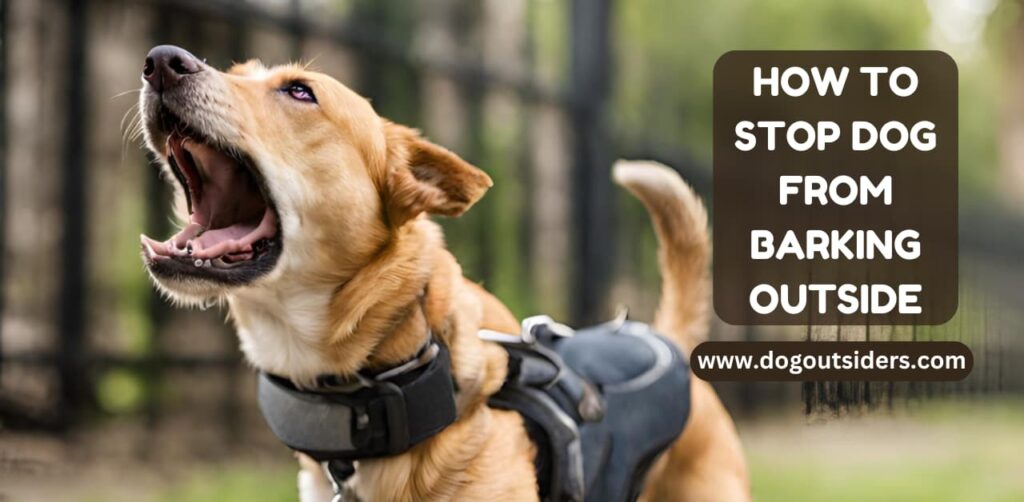When it comes to stopping a dog from barking outside, I’ve got your back. Let’s face it, constant barking can drive anyone up the wall. But fear not, there are effective ways to tackle this common canine behavior. From understanding the root cause of your pup’s excessive barking to implementing positive reinforcement techniques, we’ll cover it all. Say goodbye to those noisy disturbances and hello to a harmonious living environment for you and your furry friend. Let’s get started on ,”How to stop dog from barking outside” and create a more serene outdoor atmosphere for everyone to enjoy.
Key Takeaways
- Understand Your Dog’s Barking: Recognize why your dog is barking to address the root cause effectively.
- Ensure Proper Exercise: Regular physical activity can help reduce excessive barking by keeping your dog mentally and physically stimulated.
- Avoid Reinforcing Barking: Refrain from inadvertently rewarding barking behavior to prevent it from becoming a habit.
- Praise Quiet Moments:Acknowledge and reward your dog when they are quiet to reinforce desired behavior.
- Teach the “Quiet” Command: Train your dog to respond to a command to stop barking, promoting better communication and control.
- Limit Outdoor Freedom: Supervise outdoor time to manage barking triggers and prevent excessive vocalization.
Understanding Your Dog’s Barking
Types of Barks
Dogs bark for various reasons, including communication and expressing their needs. Different sounds indicate different emotions or messages from your pup. By paying attention to the tone and pitch, you can decipher what your dog is trying to convey.
Understanding the various types of barks, such as playful barks, aggressive barks, or anxious barks, can help you address the underlying issue causing your dog to bark excessively. Identifying these distinctions will enable you to respond appropriately and effectively.
Triggers for Barking
Recognizing the triggers that prompt your dog to bark is essential in addressing this behavior. Common triggers include other animals passing by, loud noises, or feeling territorial. By pinpointing these triggers, you can work on desensitizing your dog and modifying their response.
I have found that creating a calm environment and providing distractions can be effective in reducing excessive barking caused by triggers. For instance, engaging your dog in play or providing interactive toys can redirect their focus and minimize barking episodes.
Signs of Emotional States
Barking is a form of communication for dogs and can signify various emotional states such as boredom, anxiety, excitement, or alertness. Understanding the root cause behind your dog’s barking is crucial in addressing the behavior effectively.
To tackle boredom-induced barking, I recommend incorporating mental stimulation activities like puzzle toys or training sessions into your dog’s routine. This not only keeps them engaged but also helps alleviate any restlessness that may lead to excessive barking.
Engage in Physical Activities
Engage your dog in physical activities to reduce excessive barking. Regular walks and play sessions can help release pent-up energy. Interactive toys provide mental stimulation for your dog, keeping them entertained and less likely to bark unnecessarily.
Importance of Exercise
A well-exercised dog is less likely to bark excessively. Providing physical and mental stimulation is crucial for a well-behaved pet. Toys that dispense treats or require problem-solving skills are great options to keep your dog’s mind occupied.
Avoid Reinforcing Barking

Ignore Barking Behavior
When your dog barks excessively, refrain from yelling at them as it might worsen the situation. Instead, avoid reacting to their barking to prevent reinforcement.
Withhold Attention
By avoiding giving attention to your dog when they bark, you can discourage this behavior. Ignoring them during these instances can help in reducing barking.
Mindful Reactions
It’s crucial to be aware of how you react to your dog’s barking. Avoid unintentionally reinforcing this behavior by staying calm and composed. In my experience, I found that ignoring my dog’s barking and only rewarding quiet behavior helped in curbing excessive barking. Providing alternative activities such as interactive toys can redirect their focus away from barking. Remember, consistency is key in training your dog effectively.
Praise Quiet Moments
Acknowledge Behavior
When your dog displays quiet behavior, immediately acknowledge and reward them to reinforce this positive action. This encourages them to continue exhibiting calmness.
I always make sure to have treats handy so I can promptly reward my dog when they stay quiet for a few minutes. Positive reinforcement goes a long way in shaping their behavior.
Create a Peaceful Environment
By praising your dog for being silent, you are creating a peaceful atmosphere that reinforces the desired behavior. This helps them associate quietness with positive outcomes. In my experience, using phrases like “good quiet” or “well done for staying calm” while petting my dog has been effective in promoting quiet behavior.
Teach the “Quiet” Command

Consistent Rewards
- Reward your dog when they stop barking after hearing the “quiet” command.
- Consistently offer treats or praise to reinforce the desired behavior effectively.
Training your dog to respond to the “quiet” command involves providing positive reinforcement. When your dog stops barking upon hearing the command, immediately reward them with a treat or verbal praise. This helps them associate being quiet with receiving a reward, encouraging them to repeat the behavior in the future. Consistency is key in reinforcing this training method. Ensure that every time your dog responds appropriately to the command, you reward them promptly.
Controlled Practice
- Practice the “quiet” command in controlled environments before moving outdoors.
- Start by using familiar sounds at home to help your dog understand and respond to the command.
Before expecting your dog to stop barking outside on cue, it’s essential to practice in a controlled environment indoors. Begin by creating scenarios where your dog is likely to bark, such as doorbells ringing or strangers passing by. Use these situations to introduce the “quiet” command and provide rewards for compliance. By starting in familiar surroundings, you can help your dog grasp the concept of responding to the command before transitioning to outdoor settings.
I find that practicing patience and consistency during training sessions yields the best results. Dogs thrive on routine and clear communication, so maintaining a structured approach helps them understand what is expected of them. Remember that each dog learns at their own pace, so be patient and celebrate even small victories during training sessions.
Cue Consistency
- Use consistent cues when teaching your dog the “quiet” command.
- Ensure that all family members employ the same commands and rewards for uniformity.
When teaching your dog any new command, including “quiet,” consistency is crucial. Use a clear and distinct cue every time you want your dog to stop barking, such as saying “quiet” in a firm but calm tone. Ensure that all family members or individuals interacting with your pet use the same cue and reward system. This uniformity helps prevent confusion for your furry friend and reinforces their understanding of what is expected when they hear the command.
Incorporating consistent cues and rewards into your training sessions establishes a strong foundation for effective communication between you and your pet. By maintaining clarity in commands and responses across all interactions, you create an environment where your dog feels secure and understands how to behave appropriately.
Limit Outdoor Freedom

Supervise Activities
Supervise your dog’s outdoor activities closely to prevent excessive barking at the neighbors or strangers passing by. This allows you to intervene promptly when barking becomes uncontrollable.
Set specific boundaries within your backyard to control where your dog can roam and bark. Utilize a secure fence to limit access to certain areas, reducing triggers for unnecessary barking.
Monitor Behavior
Regularly monitor your dog’s behavior while they are in the yard to identify patterns of excessive barking. Intervene by redirecting their attention or using positive reinforcement when barking persists.
I find that establishing a routine for outdoor time helps regulate my dog’s behavior and reduces barking episodes. By consistently supervising and intervening, I’ve successfully managed my dog’s outdoor barking habits.
Basic Obedience Training
Establish Commands
Establishing basic obedience commands such as sit, stay, and come is essential for improving your dog’s behavior. These commands create a foundation for effective communication between pet parents and their furry companions.
Training sessions focused on these commands should be kept short and engaging to maintain the dog’s interest. By consistently practicing these commands, dogs learn to respond promptly and correctly in various situations.
Positive Reinforcement
Positive reinforcement techniques play a crucial role in obedience training. Rewarding good behavior with treats, praise, or toys reinforces the desired actions. This method encourages dogs to repeat behaviors that earn them rewards.
Pet parents should avoid punishment-based training methods as they can lead to fear and anxiety in dogs. Instead, emphasizing positive reinforcement helps build a strong bond based on trust and respect.
Consistency is Key
Consistency is key in obedience training to help your dog understand expectations clearly. Using the same commands and gestures each time reinforces learning and prevents confusion.
Consistent training schedules are also important for reinforcing good behavior over time. Regular practice of obedience commands ensures that dogs retain what they have learned and continue to follow instructions reliably.
Recognize and Address Triggers
Identify Triggers
When recognizing triggers for your dog’s outdoor barking, pay attention to specific stimuli or events that prompt the behavior. Common triggers include passing pedestrians, other animals, or loud noises like sirens.
One effective way to pinpoint triggers is by observing your dog’s reactions closely. Take note of what causes them to bark excessively when outside. By identifying these triggers, you can better address the underlying reasons for their behavior.
Desensitize Your Dog
To desensitize your dog to triggering stimuli, gradually expose them to these situations in a controlled manner. Start at a distance where your dog remains calm and reward them with treats for good behavior.
Slowly decrease the distance between your dog and the trigger while rewarding calm responses. This process helps your dog associate positive outcomes with previously alarming stimuli, reducing their urge to bark outdoors.
Address Anxiety and Fear
Addressing underlying anxiety or fear is crucial in curbing outdoor barking. If your dog exhibits signs of distress such as trembling or hiding, consult a professional trainer or veterinarian for guidance.
Implement calming techniques such as providing a safe space indoors during noisy times or using interactive toys to distract from anxiety-inducing triggers. By addressing these emotional factors, you can help your dog feel more secure and less likely to bark excessively outside.
When working on desensitization exercises with my own dog, I found that consistency and patience were key. It took time for my pet to adjust to certain triggers, but with positive reinforcement and gradual exposure, we saw significant improvements over time.
Incorporating rewards like favorite treats during training sessions also made the process more enjoyable for both my dog and me. Remember that each dog is unique, so tailoring your approach based on their individual triggers is essential for success.
Conclusion:
After exploring the reasons behind your dog’s barking and exploring various strategies to curb this behavior, it’s clear that consistency is key. Remember, training takes time and patience. Celebrate the quiet moments and keep reinforcing positive behaviors. Don’t forget, every pup is different, so tailor your approach to suit your furry friend’s needs. Now, armed with these tools and insights, it’s time to take action. Start implementing these tips today and watch as your dog’s barking diminishes. Together, we can create a peaceful environment for both you and your beloved pet. Happy training!
FAQ’s:
To understand your dog’s barking, pay attention to the context, pitch, and frequency. Barking could signal boredom, fear, or alertness. Observe your dog’s body language and the situation when they bark to decipher the message.
Ensure your dog receives regular walks, playtime, and mental stimulation. Different breeds have varying exercise needs. Consult with a vet or a professional trainer to determine the appropriate exercise regimen for your dog.
Avoid yelling at your dog when they bark excessively as it can reinforce the behavior. Refrain from giving attention while they are barking; instead, redirect their focus by providing a toy or engaging in a different activity.
Teach the “Quiet” command by rewarding moments of silence with treats or praise. Use consistent cues like “Quiet” when they stop barking and reward them immediately. With practice and positive reinforcement, your dog will learn to associate the command with being silent.
Identifying triggers helps you address the root cause of excessive barking. Common triggers include strangers passing by, loud noises, or separation anxiety. By recognizing these triggers, you can implement strategies to desensitize your dog or modify their environment to reduce barking episodes.







4 Comments